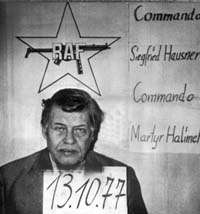Hanns Martin Schleyer
| Hanns Martin Schleyer | |
|---|---|
 | |
| Born |
1 May 1915 Offenburg, Baden, Germany |
| Died |
18 October 1977 (aged 62) en route to Mulhouse, France |
| Cause of death | Gunshot |
| Occupation | business executive, employer and industry representative |
| Spouse(s) | Waltrude Schleyer (1939–1977, his death) |
| Children | 4 |
| Relatives | Johann Martin Schleyer (great-great uncle) |
Hanns Martin Schleyer (1 May 1915 – 18 October 1977) was a German business executive and employer and industry representative, and a former SS Obersturmführer, who served as President of two powerful commercial organizations, Confederation of German Employers' Associations (Bundesvereinigung der Deutschen Arbeitgeberverbände, BDA) and Federation of German Industries (Bundesverband der Deutschen Industrie, BDI). He was targeted as an enemy by radical elements of the German student movement due to his role in those business organisations and his past activities as an officer of the SS.[1][2][3]
He was kidnapped on 5 September 1977 by the far left Red Army Faction (Rote Armee Fraktion, RAF) and subsequently murdered. The abduction and murder are commonly seen as the climax of the RAF campaign in 1977, known as the German Autumn. After his death Schleyer's former roles in the Hitler Youth and SS were forgotten, and he has been honoured in Germany; the Hanns Martin Schleyer Prize, the Hanns Martin Schleyer Foundation and the Hanns-Martin-Schleyer-Halle are named in his honour.
Early life
Born in Offenburg, Baden, Hanns Martin Schleyer came from a national-conservative family. His father was a judge and his great-great uncle was Johann Martin Schleyer, a renowned Roman Catholic priest who invented the Volapük language.
Schleyer began studying law at the University of Heidelberg in 1933, where he joined the Corps Suevia, a student fraternity. In 1939 he obtained a doctorate at the University of Innsbruck. Early in his life he became a follower of National Socialism. After a stint in the Hitler Youth, the youth organization of the National Socialist Party, he joined the SS on 1 July 1933, SS number (Nr. 221.714) and was an SS Untersturmführer (Second Lieutenant). During his studies he was engaged in the Nazi student movement. One of his mentors at this time was the student leader Gustav Adolf Scheel.
In the summer of 1935 Schleyer accused his fraternity of lacking "national socialist spirit". He left the fraternity when the Kösener SC, an umbrella organization, refused to exclude Jewish members. Schleyer became a leader in the national socialist student movement and in 1937 joined the Nazi party. At first he was the president of the student body of the University of Heidelberg. Later, Reichsstudentenführer Scheel sent him to post-Anschluss Austria where he occupied the same position at the University of Innsbruck. In 1939 Schleyer married Waltrude Ketterer (1916–2008), daughter of the physician, city councillor of Munich and SA-Obergruppenführer Emil Ketterer. They had four sons.
During World War II Schleyer was drafted and spent time on the Western Front. After an accident, he was discharged and appointed president of the student body in Prague. In this position he met Bernhard Adolf, one of the German economic leaders in the Protectorate of Bohemia and Moravia, who brought Schleyer to the industrial association of Bohemia and Moravia in 1943. Schleyer became an important deputy and adviser to Bernhard Adolf. On 5 May 1945, Schleyer escaped from the city shortly after the start of the Prague uprising.
Industrial leader in West Germany

After World War II, the Allies held Schleyer as a prisoner of war for three years because of his membership as an Untersturmführer in the SS. He was repatriated in 1948. In 1949 he became secretary of the chamber of commerce of Baden-Baden. In 1951 Schleyer joined Daimler-Benz, and, with help from a mentor, Fritz Könecke, eventually became a member of the board of directors. At the end of the 1960s, he was almost appointed chairman of the board, but lost the position to Joachim Zahn. Successively, Schleyer became more involved in employers' associations, and was a leader in employer and industry associations. He was simultaneously president of the Confederation of German Employers' Associations (BDA) and the Federation of German Industries (BDI).
His uncompromising acts during industrial protests in the 1960s such as industrial lockouts, his history with the Nazi party, and his aggressive appearance, especially on TV (The New York Times described him as a "caricature of an ugly capitalist"[4]), made Schleyer the ideal enemy for the 1968 student movement.[5]
In 1977 Schleyer debated with Heinz Oskar Vetter, chairman of the Confederation of German Trade Unions in a crosstalk at the 8. St. Gallen Symposium, which later gained a high profile, after Schleyer's kidnapping.[6]
Kidnapping and murder

See also
References
- ↑ Varon, Jamie (2004). Bringing the War Home: The Weather Underground, the Red Army Faction, and Revolutionary Violence in the Sixties and Seventies. University of California Press. pp. 197, 245, 252, 342.
- ↑ J Smith, André Moncourt. Bringing the War Home: The Weather Underground, the Red Army Faction, and Revolutionary Violence in the Sixties and Seventies. p. 477. ISBN 1604861797.
- ↑ Schmid, Thomas (19 October 2007). "Hanns Martin Schleyer, das unbekannte Opfer". Die Welt. Retrieved 2 May 2013.
- ↑ Gimlette, John (2011). Panther Soup: Travels Through Europe in War and Peace. Random House. p. 628. ISBN 9780307806369. Retrieved 2 May 2013.
- ↑ Schleyer reference, germanguerilla.com; accessed 14 November 2015.
- ↑ Frankfurter Allgemeine Zeitung, ISC-Symposium: Praktisches Management in der Villa Kunterbunt, received 2 February 2012. (German)
External links
 Media related to Hanns Martin Schleyer at Wikimedia Commons
Media related to Hanns Martin Schleyer at Wikimedia Commons
|